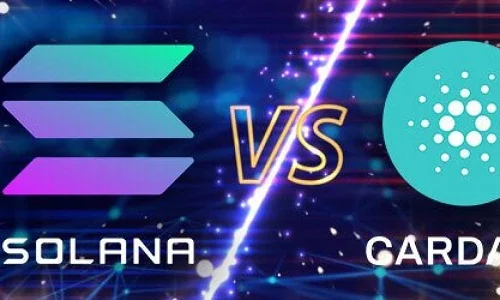
Cardano and Solana are two popular blockchain platforms that have gained significant attention in the crypto community. Both platforms aim to provide a fast and secure decentralized environment for building decentralized applications (dApps). In this article, we will discuss useful information about Cardano and Solana and how they differ from each other.
Introduction to Cardano!
Cardano is a decentralized blockchain platform that was created in 2015 by IOHK, a blockchain research company. It is a third-generation blockchain platform that aims to solve the scalability and interoperability issues faced by previous blockchain platforms. Cardano uses a proof-of-stake (PoS) consensus algorithm to validate transactions and mint new coins. It also has a smart contract language called Plutus, which enables developers to build complex dApps on the Cardano network. Staking Cardano is an additional feature that enables users to profit from staking their ADA tokens and contributes to the network’s security and decentralization.
Cardano uses a layered architecture that separates the accounting layer from the computational layer. The accounting layer is responsible for handling the transactions and maintaining the ledger, while the computational layer handles the smart contracts and dApps. This architecture enables Cardano to scale efficiently and handle a large number of transactions. Cardano also has a governance model that enables the community to vote on proposals and make decisions about the future development of the platform. This ensures that Cardano remains a decentralized and community-driven platform.
Introduction to Solana!
Solana is a high-performance blockchain platform that was created in 2017 by Solana Labs. It uses a unique consensus algorithm called Proof of History (PoH) that enables it to process over 65,000 transactions per second (TPS). Solana’s PoH algorithm provides a verifiable timestamp for each transaction, which ensures that the blockchain remains secure and tamper-proof.
Solana uses a smart contract language called Rust, which is popular among developers for its efficiency and security. It also has a unique feature called Solana Wormhole, which enables interoperability with other blockchain platforms such as Ethereum. Solana’s governance model is also community-driven, and the community has the power to vote on proposals and decide the future direction of the platform. This ensures that Solana remains decentralized and open for innovation.
Differences Between Cardano and Solana!
While both Cardano and Solana are decentralized blockchain platforms that aim to solve the scalability and interoperability issues of previous blockchain platforms, there are several differences between them.
Consensus Algorithm
Cardano uses a PoS consensus algorithm, which means that validators stake their coins to validate transactions and mint new coins. This algorithm is more energy-efficient than the proof-of-work (PoW) algorithm used by Bitcoin, but it can still be slow and expensive. Solana, on the other hand, uses a unique consensus algorithm called Proof of History (PoH), which enables it to process over 65,000 transactions per second (TPS). PoH provides a verifiable timestamp for each transaction, which ensures that the blockchain remains secure and tamper-proof.
Smart Contract Language
Cardano uses a smart contract language called Plutus, which is based on Haskell. Haskell is a functional programming language that is known for its safety and correctness. Plutus enables developers to build complex dApps on the Cardano network, but it can be challenging for developers who are not familiar with Haskell. Solana uses a smart contract language called Rust, which is popular among developers for its efficiency and security. Rust is a systems programming language that is known for its speed and low-level control. Rust enables developers to build efficient and secure dApps on the Solana network.
Scalability
Cardano uses a layered architecture that separates the accounting layer from the computational layer. This architecture enables Cardano to scale efficiently and handle a large number of transactions. Cardano can currently process around 10-15 TPS, but the platform has plans to scale to 1 million TPS in the future. Solana’s unique consensus algorithm, PoH, enables it to process over 65,000 TPS, making it one of the fastest blockchain platforms in the world. Solana’s architecture also uses a technology called “Proof of Replication” (PoRep), which enables it to scale to millions of nodes and handle massive amounts of data.
Governance
Both Cardano and Solana have a community-driven governance model that enables the community to vote on proposals and decide the future direction of the platform. This ensures that both platforms remain decentralized and open for innovation. However, Cardano’s governance model is more structured, and the community has to follow a specific process to submit and vote on proposals. Solana’s governance model is more fluid, and the community can submit proposals and vote on them without following a specific process.
Use Cases
Cardano and Solana have several use cases in different industries. Cardano’s scalability and security make it ideal for building complex dApps for industries such as finance, healthcare, and supply chain management. Cardano is also ideal for building decentralized finance (DeFi) applications, as it provides a fast and secure platform for transactions and smart contracts. Solana’s high transaction speed and low transaction fees make it ideal for building decentralized applications for gaming, social media, and e-commerce. Solana is also ideal for building payment systems and micropayments, as it enables instant transactions at a low cost.
Conclusion
Cardano and Solana are two popular blockchain platforms that aim to provide a fast and secure decentralized environment for building dApps. Both platforms have unique features that set them apart from other blockchain platforms.
Choosing between Cardano and Solana depends on the specific requirements of the project. If the project requires scalability and security, Cardano may be the better option. If the project requires high transaction speed and low transaction fees, Solana may be the better option. Ultimately, both Cardano and Solana are promising blockchain platforms that have the potential to revolutionize the blockchain industry.



Be the first to comment